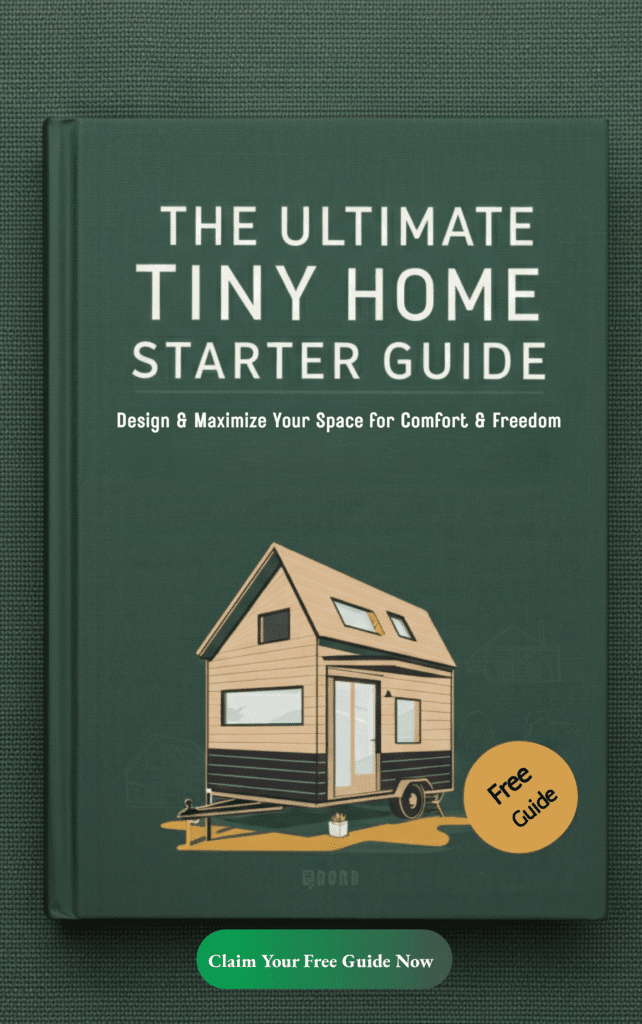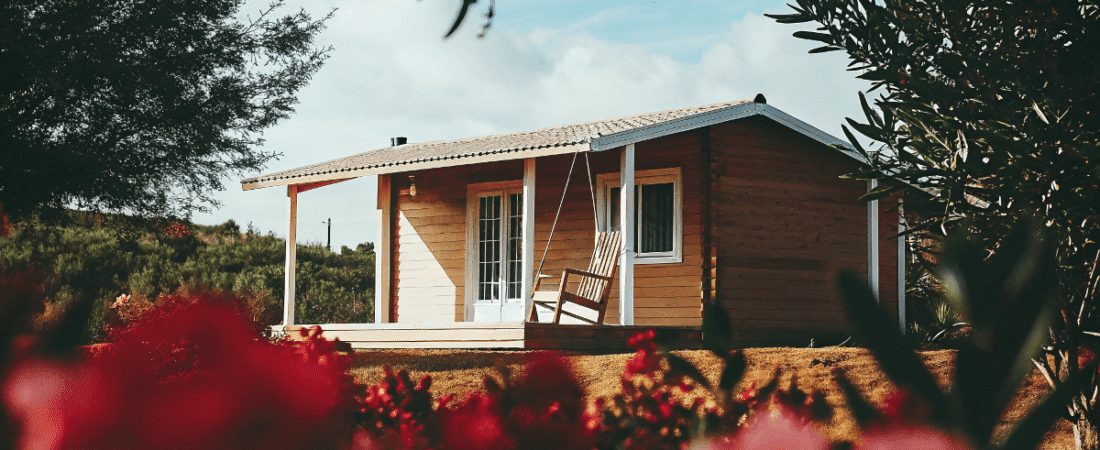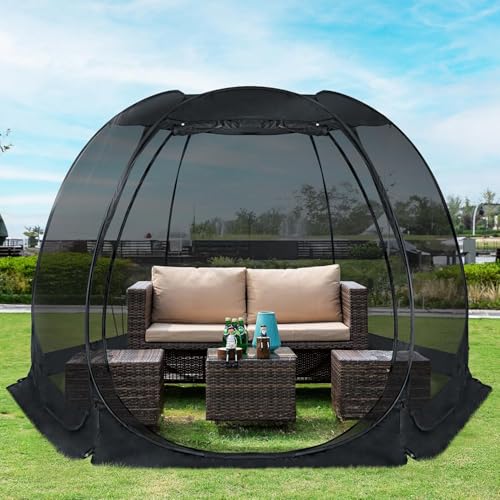Tiny house nature combines the charm of minimal living with the beauty of the great outdoors. It offers a serene getaway without forgoing all urban conveniences, providing a peaceful retreat even if you don’t permanently leave the city. It’s about simplifying life, getting back to basics, and enjoying the little things, whether perched in the mountains or near a serene lake. This lifestyle encourages a deeper connection to the environment while fostering creativity and freedom in design and space. Let’s take a look at how tiny homes can enhance your appreciation of nature!
- Nature-Inspired Interior Design
- Utilizing Small Spaces Efficiently
- Tiny House Community Living
- Sustainable Living Practices
- Connecting with the Outdoors
- Embracing Minimalism in Nature
- Gardening in a Tiny Space
- Outdoor Living Spaces
- Water Conservation Techniques
- Tiny House Retreats in Nature
- Forest Bathing and Tiny Homes
- Wildlife-Friendly Tiny Homes
- Mindful Living in a Tiny House
- The Journey to Tiny House Living
- Community Workshops in Nature
- Adapting to Seasonal Changes
- Finding Balance with Nature
- Exploring Tiny House Innovations
- The Art of Tiny House Nomadism
- Nature as a Source of Inspiration
- What is a Tiny House Nature Retreat?
- Benefits of Eco-Friendly Living in a Tiny Home
- Choosing the Right Location for Your Nature Retreat
- Sustainable Building Materials and Features
- Tips for Creating a Sustainable and Eco-Friendly Tiny House
- Top Tiny House Nature Retreats to Visit
- Building Your Own Tiny House Nature Retreat
- Conclusion
Nature-Inspired Interior Design
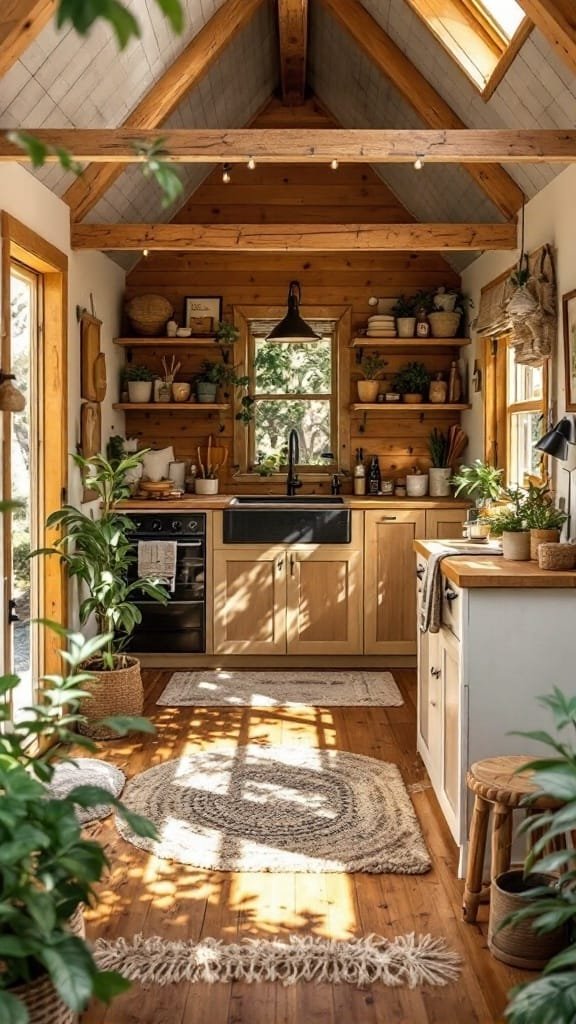
The image showcases a cozy kitchen in a tiny house, beautifully blending indoor comfort with a touch of nature. Wood beams stretch across the ceiling, creating a warm and inviting atmosphere.
Natural light pours in through the windows, highlighting the carefully arranged plants on the shelves. These green accents not only enhance the aesthetic but also bring a refreshing vibe to the space.
The kitchen features wooden cabinetry that complements the overall design. Soft textures in the rugs add comfort underfoot, making the space feel homely. This tiny house nature theme emphasizes simplicity and connection to the outdoors, allowing for a peaceful retreat.
Utilizing Small Spaces Efficiently
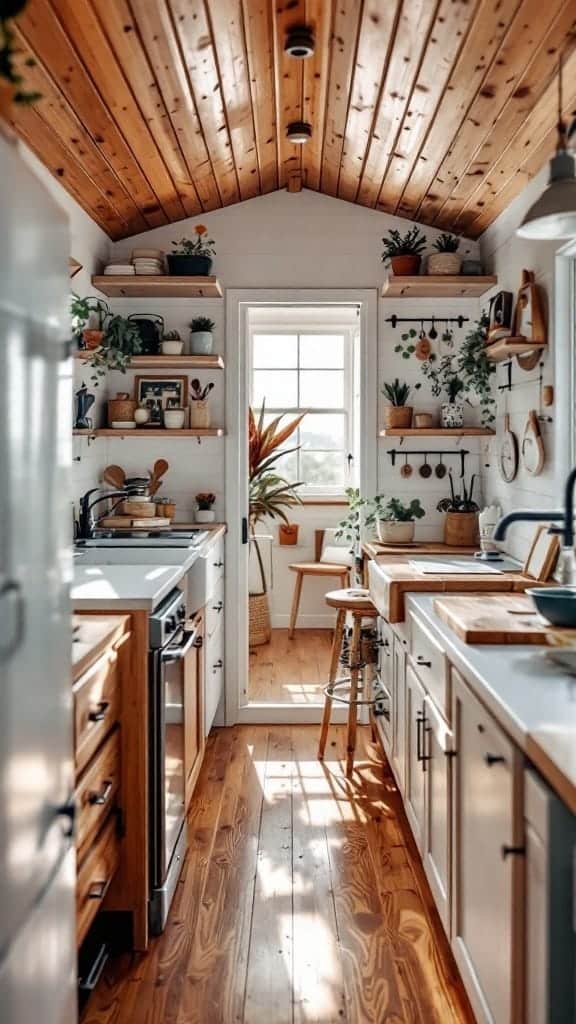
A tiny house can be a delightful place that brings you closer to nature. In the image, you see a cozy kitchen filled with natural light. The wooden ceiling adds warmth, while the carefully arranged shelves showcase plants, dishes, and tools.
Small spaces like this require smart organization. Notice how the shelves are used for both storage and decoration. This creates an inviting atmosphere where everything has its place. Each plant not only beautifies the space but also can improve air quality, making it a perfect fit for tiny house nature enthusiasts.
Every corner is maximized. The stools provide extra seating without taking up too much space. The open layout connects the kitchen to the outside, allowing fresh air and natural beauty to flow inside. In a tiny house, it’s all about making the most of what you have while keeping it functional and stylish.
Tiny House Community Living
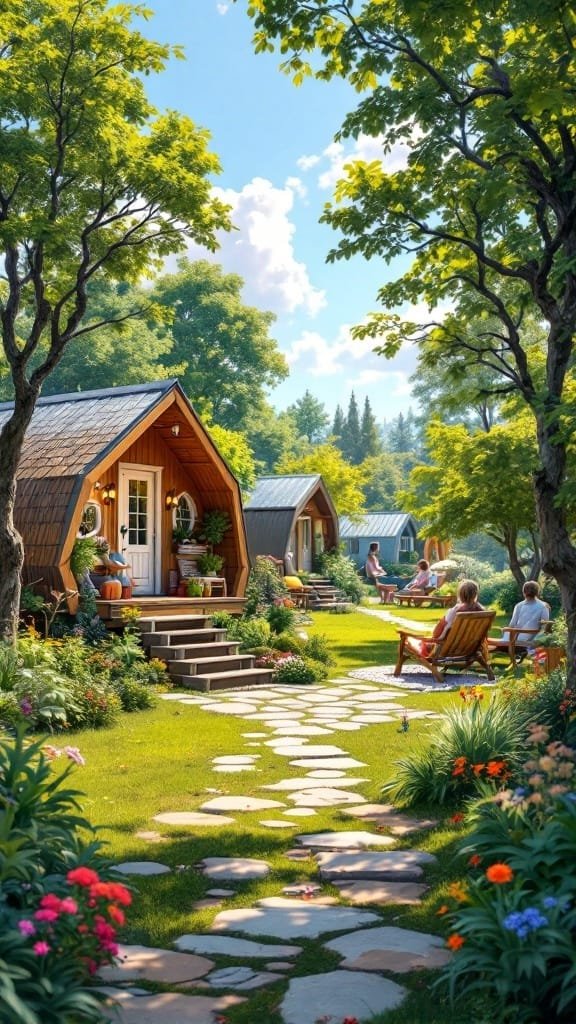
Tiny house nature creates a unique sense of community that many people find appealing. In this image, you can see charming tiny homes lined along a pathway, surrounded by lush greenery and colorful flowers. Each house has its own personality, giving the community a warm and inviting feel.
Living in a tiny house often means being part of a close-knit group. Neighbors gather in shared spaces, making connections that go beyond just living nearby. It’s common to see people relaxing on porches or enjoying the outdoors together, fostering a friendly atmosphere.
The design of these tiny homes blends seamlessly with nature, emphasizing a simpler way of living. This is not just about downsizing; it’s about enjoying life in a more connected and peaceful environment. Tiny house communities encourage residents to appreciate their surroundings, leading to a greater sense of well-being.
Sustainable Living Practices
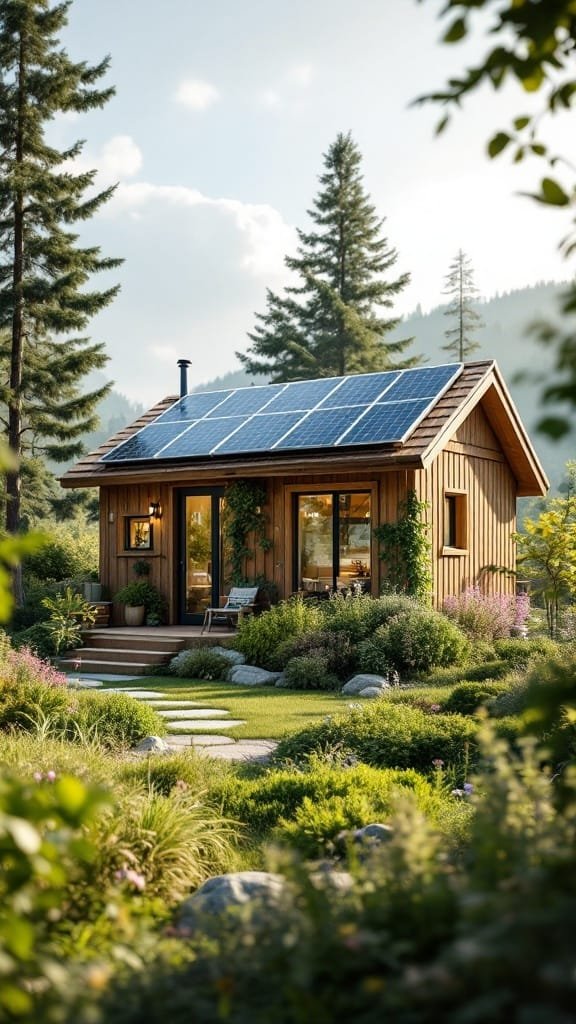
The tiny house in the image captures the essence of sustainable living. Surrounded by lush greenery, it blends perfectly with nature. The solar panels on the roof represent a commitment to renewable energy. This setup reduces reliance on traditional power sources and lowers carbon footprints. Additionally, the building process of such tiny houses often emphasizes sustainability by using renewable, local materials and minimizing waste, contrasting with conventional methods that rely on non-renewable resources.
Living in a tiny house encourages minimalism. It forces people to evaluate what they truly need. With limited space, every item has to be purposeful. This simple lifestyle can lead to less waste and a more mindful way of living.
The garden around the house showcases native plants. These require less water and care than non-native species. Plus, they provide habitats for local wildlife. By incorporating nature into our living spaces, we support biodiversity while enjoying a beautiful environment.
This tiny house nature approach highlights that sustainable living can be both practical and aesthetically pleasing. It inspires others to think about how they can incorporate similar practices in their own lives.
Connecting with the Outdoors
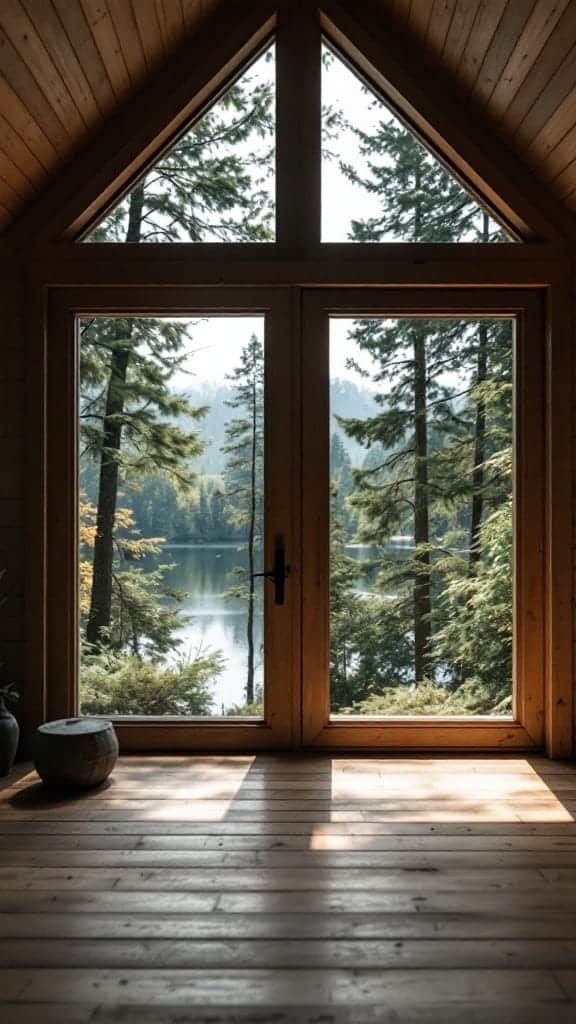
The image showcases a cozy tiny house, perfectly placed to connect with nature. Through the large windows, we can see a serene lake surrounded by tall trees. This setting invites you to step outside and enjoy the fresh air.
In a tiny house, every moment feels closer to the outdoors. The natural light that streams in creates a warm and inviting atmosphere. It’s easy to forget the busyness of life when you’re surrounded by such beauty.
Living in a tiny house offers a unique chance to embrace outdoor activities. You can go for walks by the lake, take in the sounds of nature, or enjoy a simple cup of coffee on the porch. This lifestyle encourages you to appreciate the small things.
Connecting with the outdoors is not just refreshing; it can also improve your mood and well-being. Tiny house nature truly allows you to feel at home in the great outdoors.
Embracing Minimalism in Nature
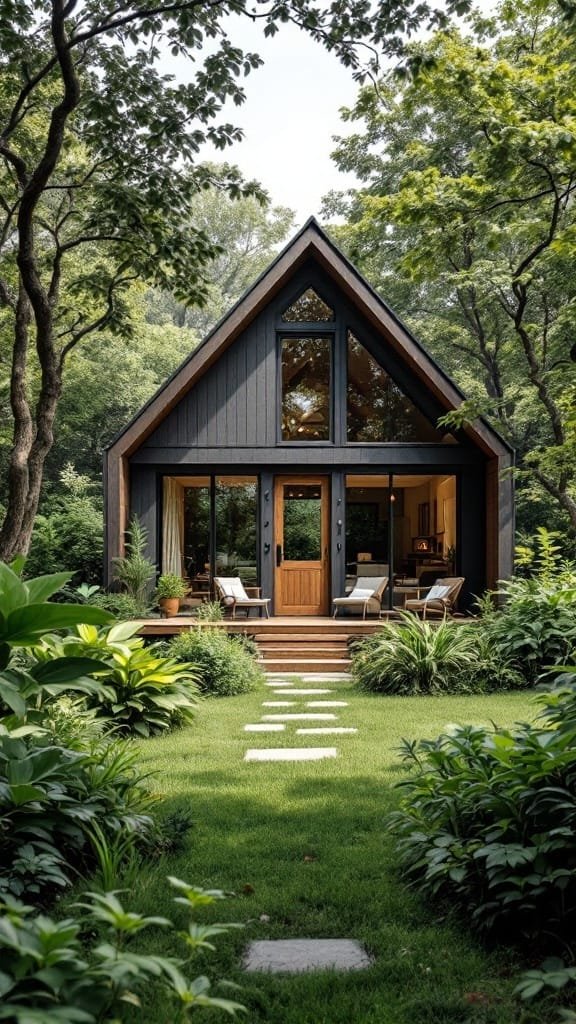
The tiny house in nature perfectly captures the essence of minimalist living. Set amidst lush greenery, it invites a sense of calm and simplicity. The design is straightforward, with clean lines and large windows allowing natural light to flood in. This is not just a house; it’s a lifestyle choice that prioritizes quality over quantity.
Surrounded by trees and plants, the house blends harmoniously with its environment. The pathway leading to the entrance, created with stone slabs, encourages a mindful stroll through the garden. Each step brings you closer to a peaceful retreat, making you appreciate the beauty of the outdoors.
Inside, the space is likely open and uncluttered. This approach allows for a more intentional way of living, focusing on what truly matters. Less stuff means less distraction, allowing you to enjoy nature and your surroundings fully. Tiny house nature living promotes a slower, more thoughtful pace of life, making it an attractive option for many.
In a world that often feels overwhelming, this tiny house serves as a reminder to cherish simplicity. It encourages us to downsize and reconnect with nature, showing that home can be both cozy and minimal.
Gardening in a Tiny Space
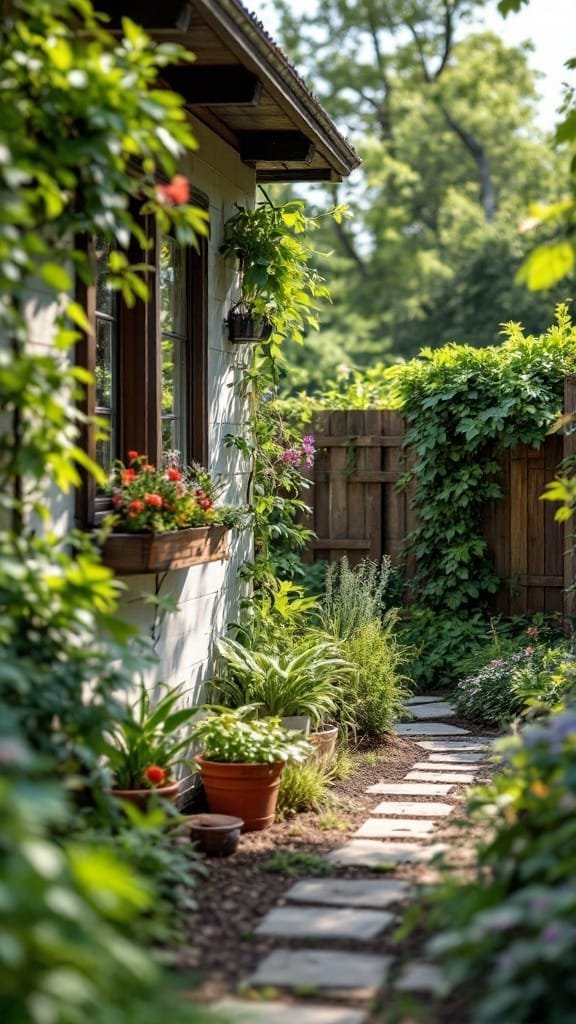
A tiny house in nature offers a unique chance to connect with the outdoors. The image shows a charming little garden path leading to the side of a cozy home. Lush greenery surrounds the walkway, showcasing how you can make the most of a small space.
In a tiny garden, every plant counts. The pots along the path add splashes of color and interest. Whether it’s flowers or herbs, choosing the right plants can create a lively atmosphere. Consider vertical gardening techniques, like hanging pots or wall planters, to utilize vertical space effectively.
Growing your own vegetables or herbs is both rewarding and practical. With limited space, small pots or raised beds can thrive in sunny spots. Think about what you love to eat, and choose plants that fit your lifestyle. A tiny house nature setting can truly turn into a self-sustaining little paradise.
Outdoor Living Spaces
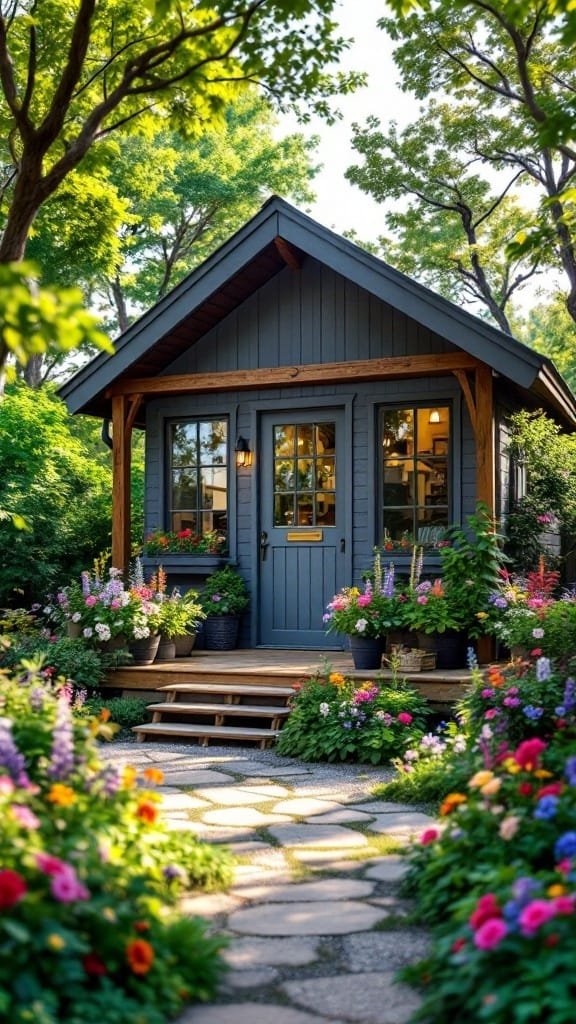
Imagine stepping into a tiny house surrounded by nature, where colorful flowers greet you at the door. This little home blends perfectly with the green landscape, offering a warm and inviting space.
The pathway leading up to the home is framed by vibrant blooms, creating a natural border. Each step takes you deeper into a world where nature and cozy living come together.
Outdoor living spaces are essential in tiny house nature. They extend your home’s footprint and encourage you to enjoy the fresh air. Picture yourself sipping coffee on the porch, surrounded by the sounds of birds and rustling leaves.
This setting isn’t just beautiful; it promotes a sense of peace and connection to the environment. Whether it’s gardening, reading, or just relaxing, outdoor spaces enhance your tiny house experience.
Water Conservation Techniques
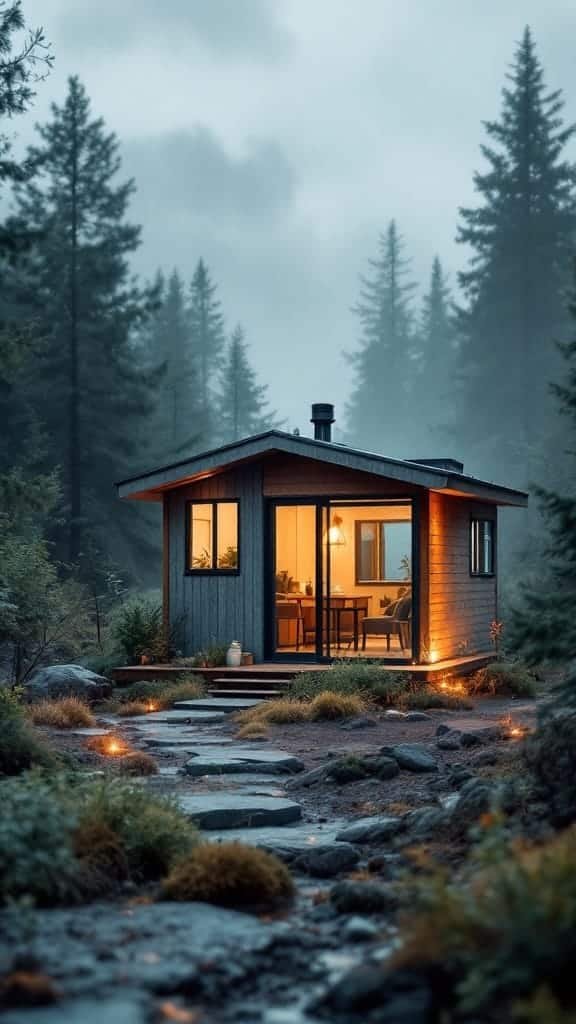
Living in a tiny house in nature encourages a thoughtful approach to water use. The cozy cabin nestled among the trees serves as a perfect reminder of how precious water is. In an environment where natural beauty surrounds you, it’s easy to appreciate the need to conserve this vital resource.
One effective technique is installing a rainwater collection system. This can be as simple as a barrel placed under a downspout. The collected water can be used for watering plants or cleaning. Tiny house nature often inspires sustainable practices like this.
Another way to save water is by using low-flow fixtures. These fixtures, like showerheads and faucets, reduce water usage without sacrificing comfort. Every drop counts when living in a compact space.
Composting toilets are also a great option. They use little to no water and turn waste into compost. This not only conserves water but also enriches the soil around your tiny home.
Finally, practicing mindful habits can make a big difference. Shortening showers and turning off the tap while brushing your teeth are simple steps everyone can take. Embracing these habits in a tiny house makes water conservation a natural part of daily life.
Tiny House Retreats in Nature
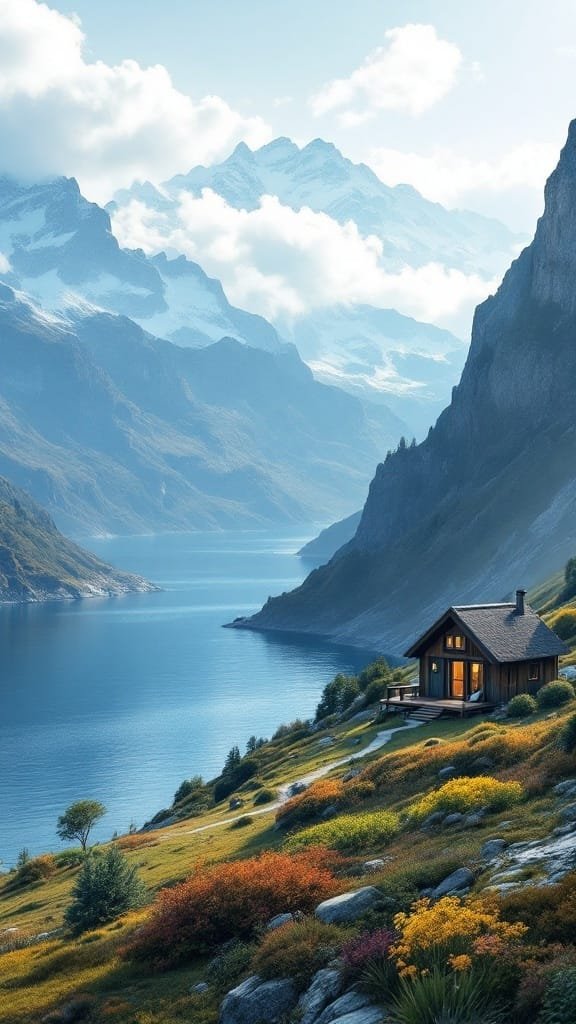
Tiny houses surrounded by nature offer a unique escape from the everyday hustle. These tiny house rentals can accommodate up to three guests. Imagine a cozy cabin sitting next to a serene lake, with towering mountains in the background. This scene captures the essence of what tiny house nature retreats are all about.
The calm waters reflect the sky, and the lush greenery adds vibrant colors to the landscape. There’s something peaceful about being in a tiny house where you can truly connect with your surroundings. Whether it’s the sound of birds or the gentle rustle of leaves, every moment spent here feels special.
Staying in a tiny house in nature allows for a simple lifestyle that many crave. You can enjoy morning coffee while watching the sunrise over the mountains or spend afternoons hiking nearby trails. Nature becomes your playground, and the tiny house serves as a perfect base for relaxation and exploration.
Forest Bathing and Tiny Homes
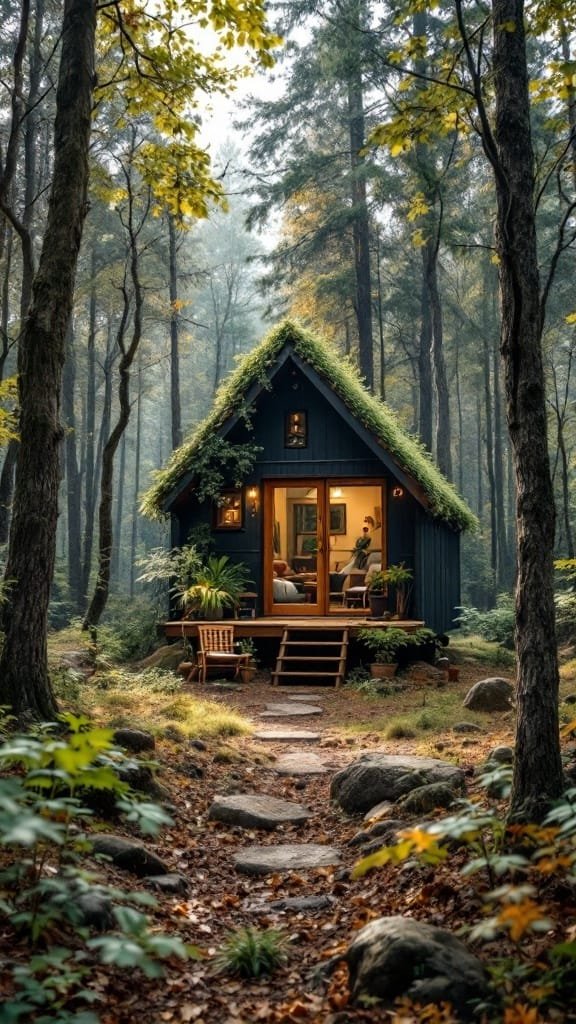
Imagine a cozy tiny house tucked away in a serene forest. This charming home, surrounded by tall trees and vibrant foliage, invites you to relax and unwind. The natural materials and earthy colors blend seamlessly with the beauty of the landscape, creating a harmonious space.
Forest bathing is all about immersing yourself in nature. When you step out of the tiny house, the fresh air fills your lungs. You can hear birds chirping and leaves rustling in the gentle breeze. This peaceful atmosphere encourages mindfulness and a deep connection with the environment.
Living in a tiny house in nature can enhance this experience. It offers a unique chance to simplify your life and focus on what truly matters. You can enjoy morning coffee on the porch, surrounded by the sights and sounds of the forest. The tiny house becomes a sanctuary, allowing you to appreciate the little things.
So, if you’re looking to escape the chaos of daily life, consider a tiny house in the woods. Embrace the simplicity and tranquility that come with it. Tiny house nature is not just a trend; it’s a lifestyle that promotes well-being and a deeper appreciation for the natural world.
Wildlife-Friendly Tiny Homes
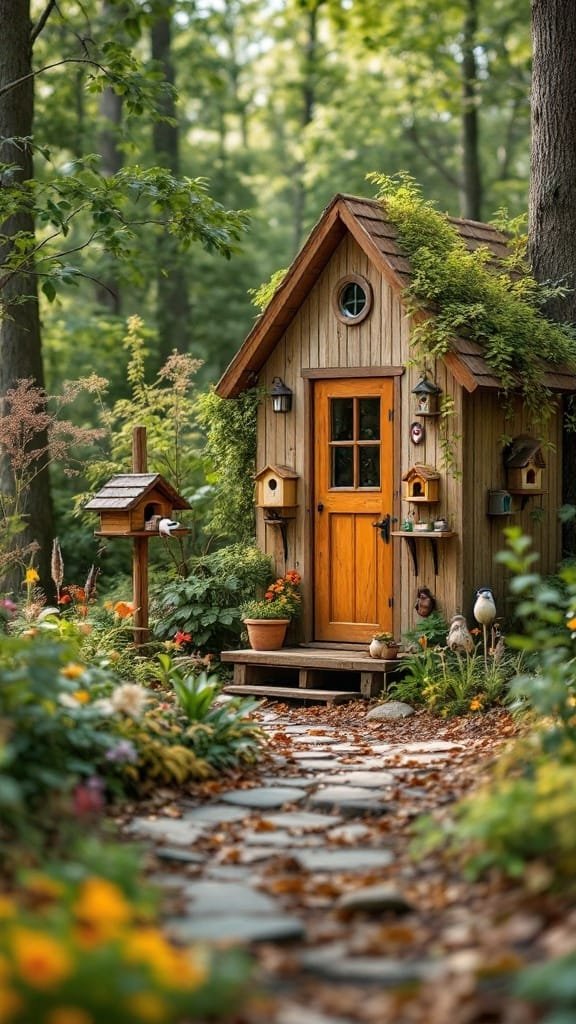
Tiny homes tucked away in nature can be a joy for both people and wildlife. The charming wooden structure in the image creates a warm and inviting space. The vibrant flowers and lush greenery surrounding it not only beautify the area but also attract various creatures.
The tiny house features birdhouses and feeders, making it a welcoming spot for birds. This thoughtful design encourages visitors from the animal kingdom to enjoy the space. A stone path leads to the front door, blending seamlessly with the natural surroundings.
Creating a wildlife-friendly tiny home means incorporating elements that support local species. Plants native to the area provide food and shelter for wildlife, enhancing the tiny house nature experience. Adding features like water sources or bee hotels can further enrich the habitat.
Overall, living in harmony with nature is the essence of wildlife-friendly tiny homes. They encourage a peaceful coexistence, allowing residents to enjoy the beauty of the outdoors while supporting the local ecosystem.
Mindful Living in a Tiny House
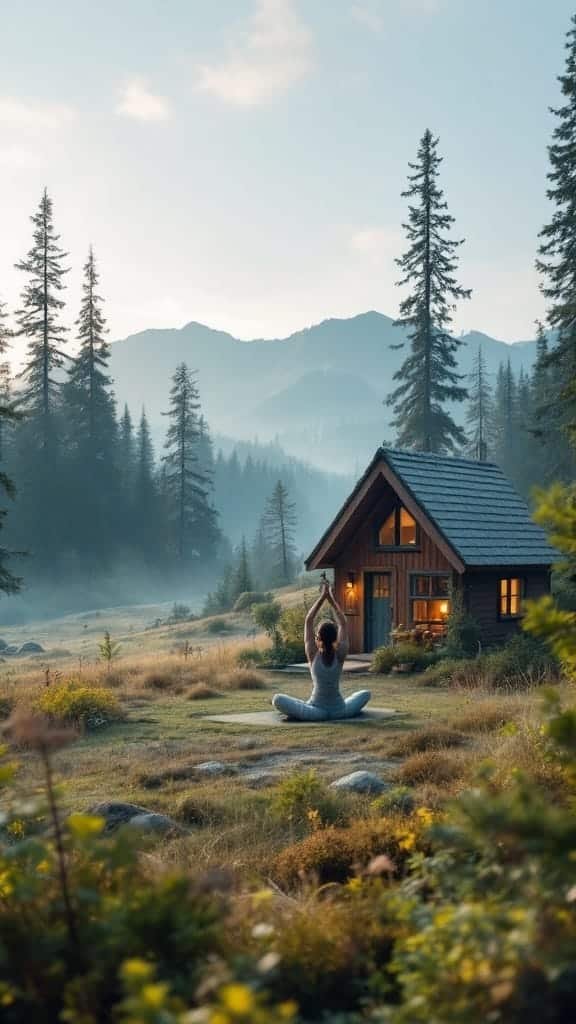
The image captures a serene moment in nature, featuring a tiny house surrounded by tall trees and rolling mountains. A person practices yoga outside the cozy structure, embracing the tranquility of the environment. This scene beautifully illustrates the concept of tiny house nature.
Living in a tiny house encourages mindfulness. The simplicity of a smaller space helps to focus on what truly matters. With fewer distractions, one can enjoy the beauty of natural surroundings, just like the person in the image. This lifestyle can lead to a deeper connection with nature.
Finding peace in a tiny house means creating a sanctuary. The outdoor setting invites relaxation and reflection. Engaging in activities like yoga enhances mental clarity and physical well-being. This small living approach allows for moments of stillness amidst the hustle of life.
This lifestyle shift not only supports personal well-being but also promotes sustainability. Tiny houses often use fewer resources, aligning with a mindful approach to living. By embracing tiny house nature, individuals can cultivate a harmonious existence with their surroundings.
The Journey to Tiny House Living
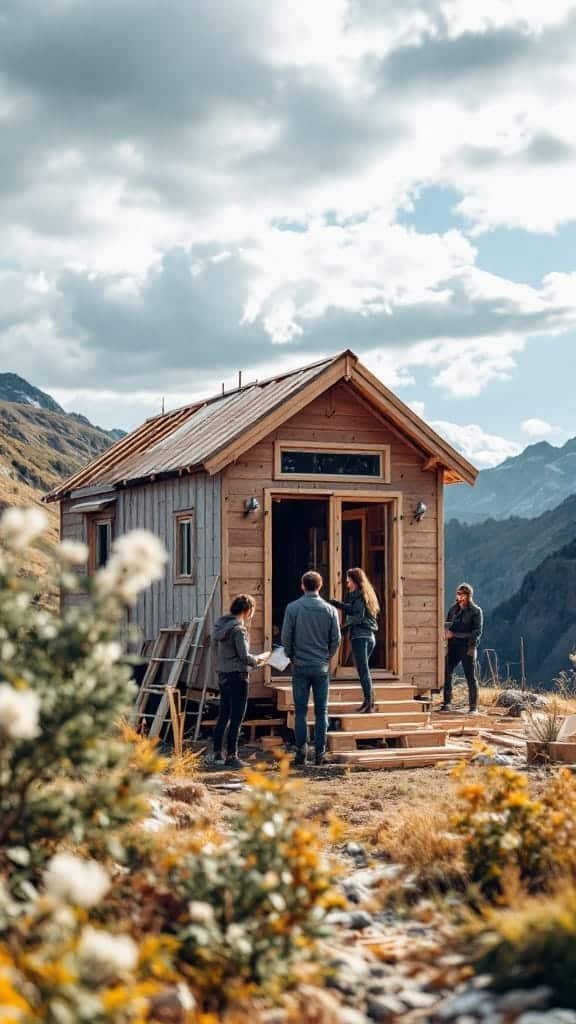
Imagine stepping into a tiny house surrounded by stunning nature. The image captures a small wooden home nestled in the mountains, with people actively engaged in its creation. The middle layer of the cordwood wall acts as a thermal block, ensuring the house remains energy efficient. A group of four individuals is seen working together, some holding plans and others preparing to complete the build. The beauty of tiny house nature is evident here, where the simplicity of living harmonizes with the lush surroundings.
This scene portrays the excitement of building a tiny home. It’s not just about the structure; it’s about a lifestyle choice. People are drawn to tiny house living for various reasons, from minimizing expenses to embracing a more sustainable way of life. The fresh air and scenic views serve as a perfect backdrop for those looking to simplify.
The camaraderie in the image highlights the communal aspect of tiny house projects. Friends or family coming together can make the process enjoyable and rewarding. It’s a shared experience that blends teamwork with the joys of nature. Whether you’re constructing your first tiny home or helping a friend, there’s a sense of fulfillment that comes with each step.
Community Workshops in Nature
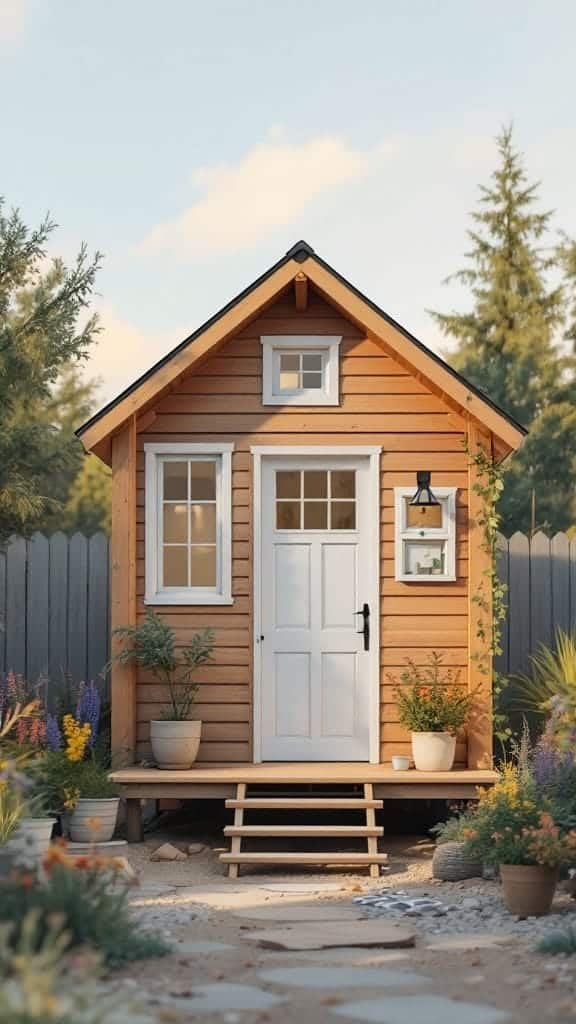
Picture a cozy scene where people gather in the woods, surrounded by the beauty of fall. This image captures a group engaged in a workshop, all focused on tiny house nature. It’s a perfect mix of learning and community.
The tiny house in the background stands as a simple yet functional space. It’s a reminder that living small can mean living large in experiences. Participants seem eager, sharing ideas and enjoying the moment together.
Workshops like these offer a chance to dive into sustainable living and home-building techniques. Nature provides the ideal backdrop, inspiring creativity and connection. It’s not just about the houses; it’s about building relationships and sharing knowledge in a serene setting.
With every conversation, participants learn how to embrace a simpler lifestyle, one that resonates with the environment. The joy of gathering in nature and discussing tiny houses creates a warm, welcoming vibe that makes everyone feel at home.
Adapting to Seasonal Changes
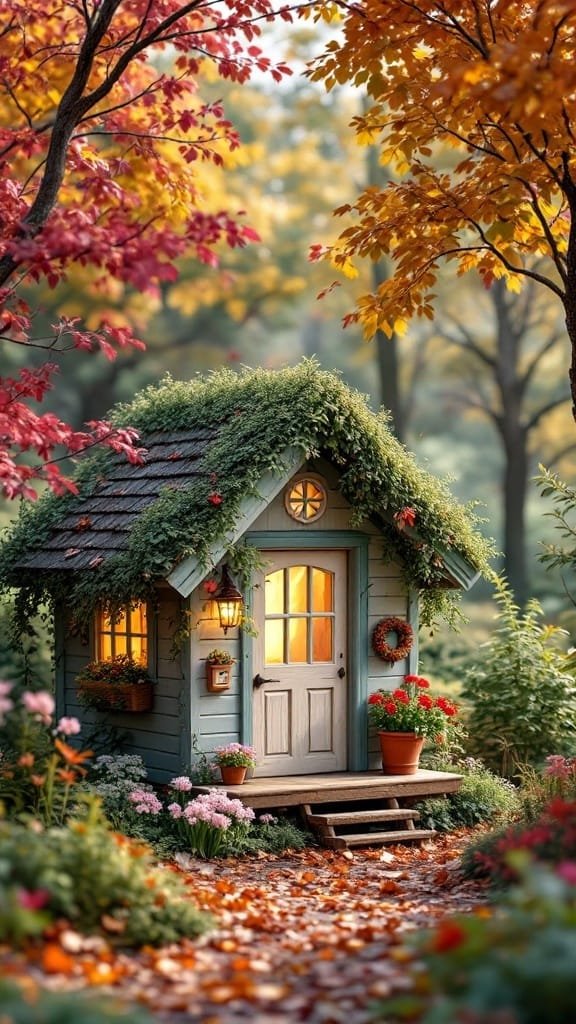
The charm of a tiny house nestled in nature shines through each season. As trees change colors and flowers bloom, this little home stands as a perfect example of embracing the outdoors. With vibrant leaves painting the ground in shades of orange and red, it feels like stepping into a cozy fairy tale.
In the fall, the house becomes a warm retreat, inviting you to enjoy the crisp air and watch the leaves dance. The glow from the windows hints at comfort inside, where you can sip hot cocoa and listen to the rustle of leaves. Materials with high thermal mass can maintain warmth during the night after absorbing heat from the sun during the day, particularly in locations with significant temperature fluctuations between day and night. Nature’s beauty surrounds this tiny home, reminding us to appreciate each moment.
As winter approaches, the tiny house transforms again. If snow blankets the ground, the house becomes a picturesque winter wonderland. It’s a perfect spot for cozy evenings by the fire, wrapped in blankets while the snowflakes gently fall outside.
Spring brings new life and colorful blooms, with flowers bursting through the ground, adding vibrancy to the tiny house’s entrance. The fresh scent of blossoms fills the air, encouraging everyone to step outside and enjoy nature’s renewal.
Summer wraps the tiny house in lush greenery, creating a refreshing escape. The garden around it is alive with colors, inviting outdoor gatherings and lazy afternoons. This tiny house in nature tells us that adapting to each season creates a deeper connection to our environment and offers unique experiences year-round.
Finding Balance with Nature
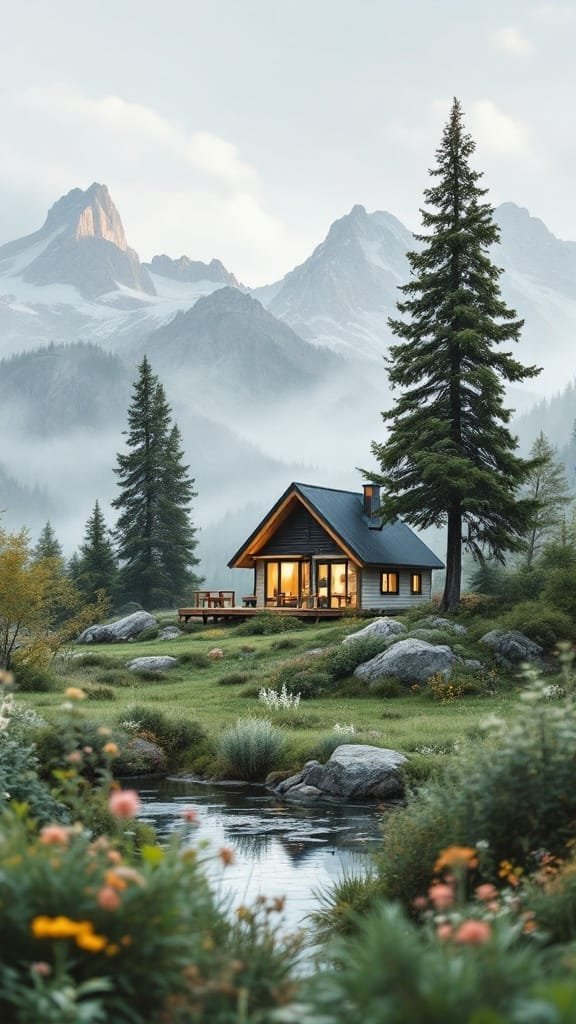
Imagine a cozy tiny house nestled in the heart of nature. It sits quietly by a sparkling stream, surrounded by towering trees and majestic mountains. The soft glow from the windows invites you in, offering warmth and comfort.
This scene is a perfect reminder of how we can find balance with nature. The tiny house represents a simple lifestyle, allowing us to reconnect with what truly matters. It encourages us to slow down and appreciate the beauty around us.
Living in such harmony with nature means embracing the sights and sounds of the wild. The whisper of the wind through the trees, the chirping of birds, and the gentle flow of water all create a serene environment. This tiny house nature experience becomes more than just a getaway; it turns into a way of life.
When we think about tiny houses, we often picture minimalism. It’s not just about the house itself, but the lifestyle it promotes. It invites a deeper appreciation for the outdoors and encourages sustainability. Choosing a home surrounded by such beauty inspires us to protect our environment.
In this setting, every detail matters. From the colorful flowers that bloom nearby to the rocky paths leading to the mountains, everything enhances our connection to nature. The tiny house stands as a symbol of living lightly on the earth. It reminds us to cherish our surroundings and find joy in simplicity.
Exploring Tiny House Innovations
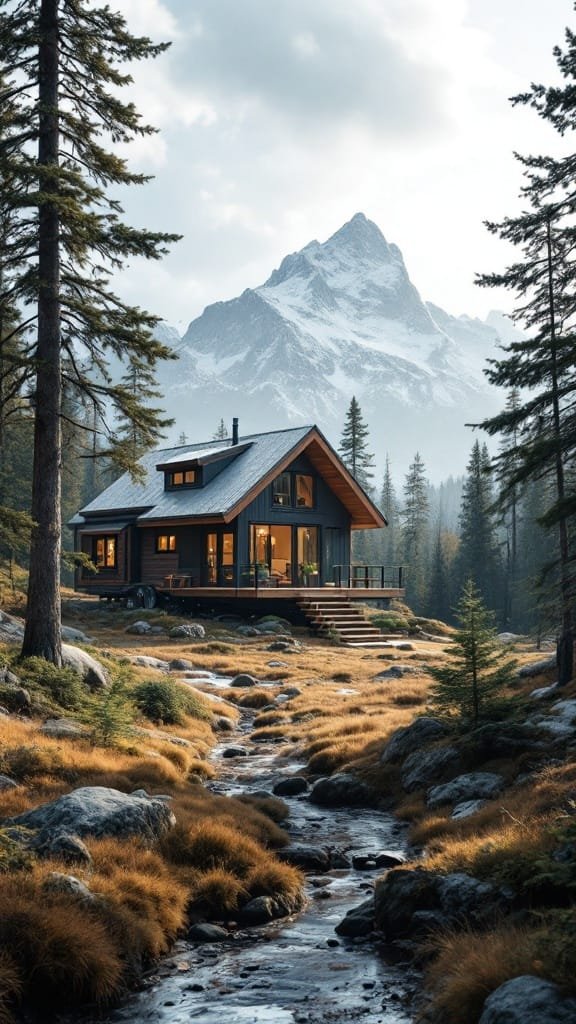
The image of a charming tiny house surrounded by nature perfectly captures the essence of tiny house living. This cozy dwelling sits on the edge of a serene stream, with majestic mountains standing tall in the background. The natural landscape enhances the appeal of the home, showcasing how tiny houses can harmonize with their environment.
This tiny house exemplifies innovation in design and sustainability. Built with large windows, it invites natural light, creating a warm and inviting atmosphere. The earthy colors and wooden materials blend seamlessly into the landscape, emphasizing the theme of tiny house nature. Living in such a setting inspires a connection to the outdoors, promoting a lifestyle that values simplicity and tranquility.
Moreover, tiny houses often come with clever storage solutions and multifunctional spaces. This allows residents to maximize their living area while minimizing their footprint. The focus on minimalism encourages a lifestyle that prioritizes experiences over possessions, aligning perfectly with the beauty of nature depicted in the image. Tiny house living is not just a trend; it’s a movement towards a more mindful way of life.
The Art of Tiny House Nomadism
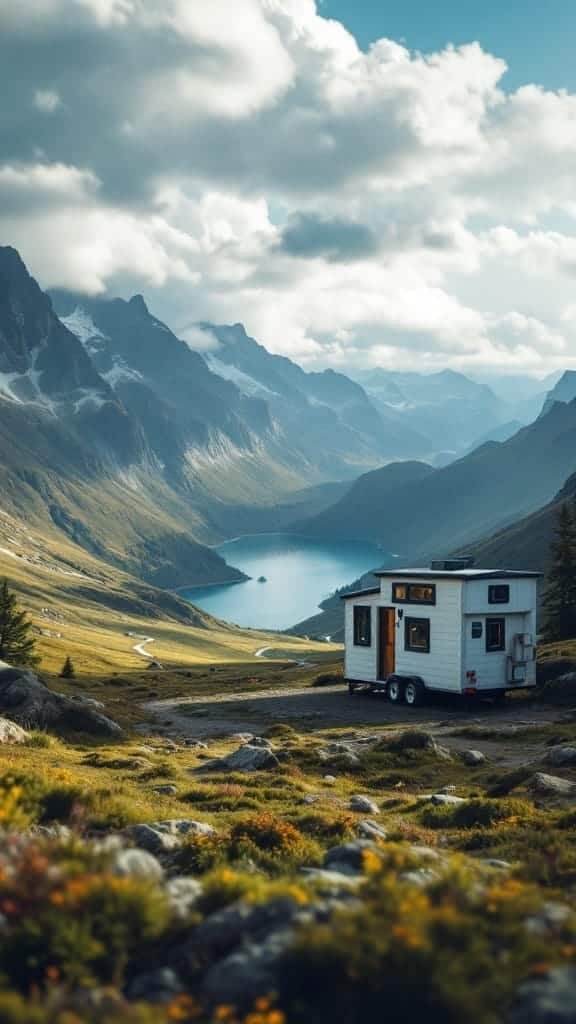
Tiny house nature is not just a design choice; it’s a lifestyle. Imagine a cozy little home parked in a breathtaking landscape. The image shows a tiny house set against towering mountains and a serene lake. This setup captures the essence of living small while embracing the beauty of the great outdoors.
In tiny house nomadism, every detail matters. The compact space often holds all the essentials for living, from a small kitchen to a comfy sleeping area. This minimalistic approach allows individuals to prioritize experiences over possessions. Living in nature offers a unique sense of freedom.
Exploring different environments is part of the fun. With a tiny house, you can change your view whenever you like. Whether it’s mountains, lakes, or forests, each location offers its own charm. This constant change keeps life exciting and vibrant.
Being close to nature enhances well-being. Fresh air, stunning views, and the sounds of wildlife create a peaceful atmosphere. Many find that living in a tiny house fosters a deeper connection to the environment. It reminds us of the beauty that surrounds us every day.
Nature as a Source of Inspiration
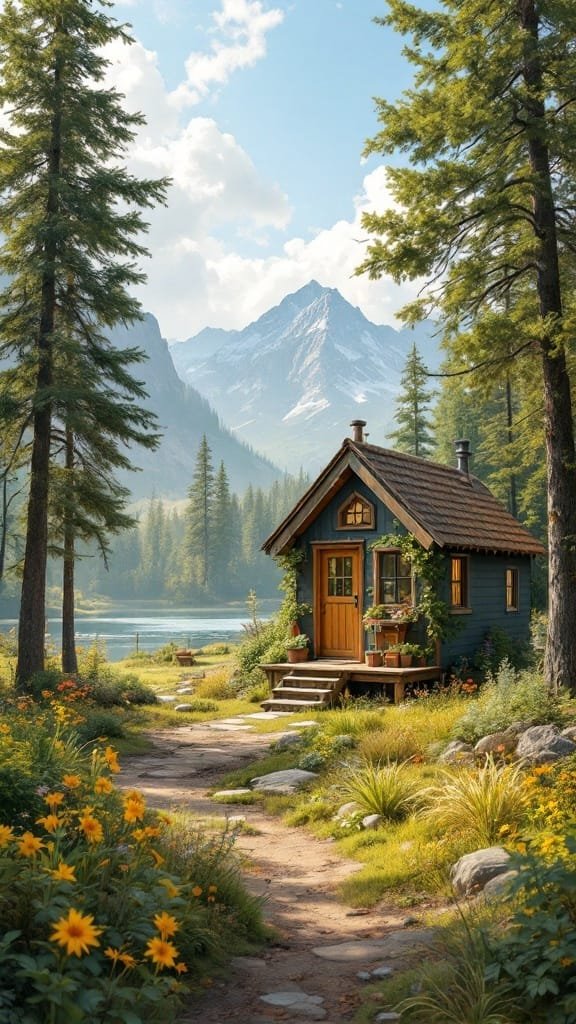
The image of a tiny house surrounded by nature is a perfect reminder of how the outdoors can inspire us. The small cabin, with its charming design, blends beautifully with the lush greenery and vibrant flowers. This setting invites us to slow down and appreciate the simple joys of life.
Look at the mountains in the background, standing tall and majestic. They remind us of the strength and beauty found in nature. The clear blue sky brings a sense of peace, encouraging us to breathe deeply and enjoy the moment. Nature truly offers a canvas for imagination.
Walking along the stone path leading to the tiny house, one can almost feel the soft rustle of leaves and the gentle flow of water nearby. This connection to the natural world can spark creativity and reflection. Tiny house nature brings us closer to our roots, showing us how a small, cozy space can be a sanctuary for the soul.
What is a Tiny House Nature Retreat?
- A tiny house nature retreat is a small, environmentally friendly dwelling that allows individuals to connect with nature and live a more sustainable lifestyle.
- These retreats are often located in natural settings, such as woods or mountains, and are designed to minimize their impact on the environment.
- Tiny house nature retreats can be used as vacation homes, permanent residences, or even as a way to test out tiny house living before committing to it full-time.
Benefits of Eco-Friendly Living in a Tiny Home
- Living in a tiny house nature retreat can help reduce one’s environmental footprint and promote a more sustainable lifestyle.
- Tiny houses are often built using natural and sustainable materials, such as reclaimed wood and low-VOC paints.
- The small size of tiny houses means they require less energy to heat and cool, making them a more environmentally friendly option.
- Tiny house living can also promote a sense of community and connection with nature.
Choosing the Right Location for Your Nature Retreat
- When choosing a location for your tiny house nature retreat, consider factors such as climate, accessibility, and natural beauty.
- Look for locations that are surrounded by nature, such as woods or mountains, and offer opportunities for outdoor activities like hiking and birdwatching.
- Consider the proximity to cities and towns, as well as the availability of amenities like grocery stores and healthcare facilities.
- Research local building codes and regulations to ensure that your tiny house nature retreat complies with all requirements.
Sustainable Building Materials and Features
When building a tiny house nature retreat, consider using sustainable building materials like reclaimed wood, bamboo, and low-VOC paints.
Look for materials that are locally sourced and have a low environmental impact. Walls made from materials such as hempcrete and rammed earth are strong, sustainable, and historically significant. Hempcrete walls can be formed and stacked similarly to concrete, while rammed earth provides sturdy, load-bearing walls that have been used for centuries.
Consider incorporating natural building features like earthbags, cordwood, and rammed earth into your design.
Incorporate energy-efficient features like solar panels and rainwater harvesting systems to reduce your reliance on public utilities.
Tips for Creating a Sustainable and Eco-Friendly Tiny House
Creating a sustainable and eco-friendly tiny house requires careful planning and a commitment to reducing your environmental footprint. Here are some tips to help you get started:
- Choose Sustainable Materials: Opt for reclaimed wood, bamboo, and low-VOC paints. These materials are not only environmentally friendly but also add unique character to your tiny home.
- Incorporate Energy-Efficient Features: Install solar panels to harness renewable energy and reduce reliance on public utilities. Consider rainwater harvesting systems to collect and reuse water for gardening and other needs.
- Maximize Natural Light: Design your tiny house with large windows to allow natural light to flood in. This reduces the need for artificial lighting and creates a warm, inviting atmosphere.
- Utilize Space Efficiently: Smart storage solutions and multifunctional furniture can help you make the most of your limited space. This not only keeps your tiny house organized but also enhances its functionality.
- Embrace Minimalism: Focus on what truly matters and avoid unnecessary clutter. A minimalist lifestyle promotes sustainability and allows you to fully appreciate the beauty of your surroundings.
- Connect with Nature: Design outdoor living spaces, such as a porch or garden, to extend your living area and encourage you to spend more time outdoors. This enhances your connection with nature and promotes a sense of well-being.
By following these tips, you can create a tiny house that is both sustainable and beautifully designed, allowing you to enjoy the benefits of eco-friendly living in harmony with nature.
Top Tiny House Nature Retreats to Visit
- The Luxury Vermont tiny house in Windham, VT, is a beautifully designed tiny house surrounded by nature and offering high-end amenities.
- The Nature.house tiny house in Europe offers a peaceful retreat in the woods, perfect for connecting with nature and relaxing.
- The Tiny House in the Woods in Romania is a sustainable and eco-friendly living space made from natural materials like cob and straw.
Building Your Own Tiny House Nature Retreat
- If you’re interested in building your own tiny house nature retreat, consider taking a natural building course or workshop to learn the skills you need.
- Research local building codes and regulations to ensure that your tiny house complies with all requirements.
- Consider working with a professional builder or contractor who has experience with natural building and sustainable materials.
- Join online communities and forums to connect with other tiny house enthusiasts and learn from their experiences.
Conclusion
- Tiny house nature retreats offer a unique and sustainable way to connect with nature and live a more environmentally friendly lifestyle.
- By choosing the right location, using sustainable building materials, and incorporating eco-friendly features, you can create a tiny house nature retreat that is both beautiful and sustainable.
- Whether you’re looking to build your own tiny house or simply visit one, there are many options available to suit your needs and preferences.

